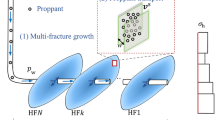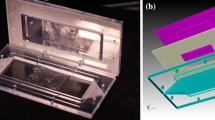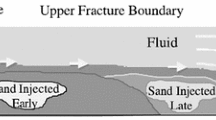Abstract
Hydraulically fractured well productivity greatly depends on fracture conductivity, which itself is dictated by proppant transport and placement. To guide engineering design and evaluate performance of proppant placement, a full understanding of the underlying physics and robust numerical models are needed. This paper introduces a continuum approach for simulating the transport of multiple fluids and proppant particles within hydraulic fractures. To achieve computational efficiency, this proppant model is developed based on the assumption of multi-component single phase flow and captures proppant settling, hindering effects, proppant-bed erosion and transport. Inter-particle stresses and collisions are not numerically calculated but represented through empirical correlations to include the effects of particle clustering and hindered settling. This model couples the fluid phase and particle phase through the slip velocity, which is governed by particle settling, particle–particle interaction and fluid-particle drag forces. The presented proppant model is validated by comparing numerical results with experimental data. With the calibrated simulation, the modeling capabilities on fracturing treatment design are demonstrated through sensitivity analysis and field-scale applications. Moreover, based on proppant placement and deformation, a generic model is applied to forecast fracture conductivity in different scenarios. As illustrated in this study, this coupled three-dimensional model is capable of simulating proppant placement and fracture conductivity under various operational conditions. This model can be broadly applied to improve fracturing design in various formations, including tight sandstone, shale, coal bed methane and carbonate reservoirs.
Highlights
-
To achieve computational efficiency, we introduce a continuum approach for simulating the transport of multiple fluids and proppant particles.
-
In this new model, several underlying mechanisms are considered to highlight the coupling between proppant transport and fluid flow.
-
The modelling predictions on proppant transport and distribution show a good agreement with the reported experimental data.
-
Using the model calibrated to lab tests, the modeling capability is demonstrated and controlling parameters on proppant transport are identified.
-
This model works for field-scale hydraulic fracturing simulations to model proppant transport and fracture conductivity evolution.
















Similar content being viewed by others
References
Abass HH, Al-Mulhem AA, Alqam MH, Khan MR (2006) Acid Fracturing or Proppant Fracturing in Carbonate Formation? A Rock Mechanics View. In: SPE Annual Technical Conference and Exhibition, San Antonio, Texas, SPE-102590-MS
Adachi J, Siebrits E, Peirce A, Desroches J (2007) Computer simulation of hydraulic fractures. Int J Rock Mech Min Sci 44:739–757. https://doi.org/10.1016/j.ijrmms.2006.11.006
Aften C (2018) Analysis of Various High Viscosity Friction Reducers and Brine Ranges Effectiveness on Proppant Transport. In: SPE/AAPG Eastern Regional Meeting, Pittsburgh, Pennsylvania
Almulhim A, Kebert B, Miskimins J, Hunter W, Soehner G (2020) Field-Scale Computational Fluid Dynamics CFD Modeling of Proppant Transport and Distribution Within a Horizontal Hydraulic Fracturing Stage. In: SPE Hydraulic Fracturing Technology Conference and Exhibition, The Woodlands, Texas
Alotaibi MA, Miskimins JL (2018) Slickwater proppant transport in hydraulic fractures: new experimental findings and scalable correlation. SPE Prod & Oper 33:164–178. https://doi.org/10.2118/174828-PA
Andrews MJ, O’Rourke PJ (1996) The multiphase particle-in-cell (MP-PIC) method for dense particulate flows. Int J Multiph Flow 22:379–402
Ba Geri M, Imqam A, Flori R (2019) A Critical Review of Using High Viscosity Friction Reducers as Fracturing Fluids for Hydraulic Fracturing Applications. In: SPE Oklahoma City Oil and Gas Symposium, Oklahoma City, Oklahoma
Babcock RE, Prokop CL, Kehle RO (1967) Distribution of propping Agent in vertical Fractures. In: Drilling and Production Practice, New York, New York
Baihly JD, Malpani R, Altman R, Lindsay G, Clayton R (2015) Shale Gas Production Decline Trend Comparison Over Time and Basins—Revisited. In: Unconventional Resources Technology Conference, San Antonio, Texas
Barree RD, Conway MW (1995) Experimental and numerical modeling of convective proppant transport (includes associated papers 31036 and 31068). J Pet Technol 47:216–222. https://doi.org/10.2118/28564-PA
Barree RD, Miskimins JL, Conway MW, Duenckel R (2017) Generic correlations for proppant-pack conductivity. SPE Prod & Oper 33:509–521. https://doi.org/10.2118/179135-PA
Biot MA, Medlin WL (1985) Theory of Sand Transport in Thin Fluids. In: SPE Annual Technical Conference and Exhibition, Las Vegas, Nevada
Blyton CAJ, Gala DP, Sharma MM (2018) A study of proppant transport with fluid flow in a hydraulic fracture. SPE Drill Complet 33:307–323
Carman PC (1937) Fluid flow through granular beds. Trans Inst Chem Eng 15:150–166
Chun T, Li Y, Wu K (2020) Comprehensive experimental study of proppant transport in an inclined fracture. J Petrol Sci Eng 184:106523. https://doi.org/10.1016/j.petrol.2019.106523
Clark PE, Quadir JA (1981) Prop Transport In Hydraulic Fractures: A Critical Review Of Particle Settling Velocity Equations. In: SPE/DOE Low Permeability Gas Reservoirs Symposium, Denver, Colorado
Cleary MP, Fonseca A (1992) Proppant convection and encapsulation in hydraulic fracturing: practical implications of computer and laboratory simulations. In: SPE annual technical conference and exhibition, Washington, D.C.
Cohen CE, Abad C, Weng X, England K, Phatak A, Kresse O, Nevvonen O, Laffite V, Abivin P (2013) Analysis on the impact of fracturing treatment design and reservoir properties on production from shale gas reservoirs. In: International Petroleum Technology Conference, Beijing, China
Dontsov EV, Peirce AP (2014) Slurry flow, gravitational settling and a proppant transport model for hydraulic fractures. J Fluid Mech 760:567–590
Dontsov EV, Peirce AP (2015a) A Lagrangian approach to modelling proppant transport with tip screen-out in KGD hydraulic fractures. Rock Mech Rock Eng 48:2541–2550
Dontsov EV, Peirce AP (2015b) Proppant transport in hydraulic fracturing: crack tip screen-out in KGD and P3D models. Int J Solids Struct 63:206–218
Dunand A, Soucemarianadin A (1985) Concentration effects on the settling velocities of proppant slurries. In: SPE annual technical conference and exhibition, Las Vegas, Nevada
Gadde PB, Liu Y, Norman J, Bonnecaze R, Sharma MM (2004) Modeling proppant settling in Water-Fracs. In: SPE annual technical conference and exhibition, Houston, Texas
Garagash IA, Osiptsov AA, Boronin SA (2019) Dynamic bridging of proppant particles in a hydraulic fracture. Int J Eng Sci 135:86–101
Gomaa AM, Gupta DV, Carman P (2015) Proppant transport? Viscosity is not all it's cracked up to be. In: SPE hydraulic fracturing technology Conference, The Woodlands, Texas
Gu M, Mohanty KK (2014) Effect of foam quality on effectiveness of hydraulic fracturing in shales. Int J Rock Mech Min Sci 70:273–285
Guo Y, Wang L, Chang X, Zhou J, Zhang X (2020) Study on fracture morphological characteristics of refracturing for longmaxi shale formation. Geofluids 2020
Hosseini N, Khoei AR (2020) Numerical simulation of proppant transport and tip screen-out in hydraulic fracturing with the extended finite element method. Int J Rock Mech Min Sci 128:104247
Hryb D, Archimio A, Badessich M, Ejofodomi E, Diaz A, Cavazzoli G, Zalazar F, Lagarrigue E, Pichon S (2014) Unlocking the True Potential of the Vaca Muerta Shale via an Integrated Completion Optimization Approach. In: SPE Annual technical conference and exhibition. Amsterdam, The Netherlands
Hu X, Wu K, Song X, Yu W, Tang J, Li G, Shen Z (2018) A new model for simulating particle transport in a low-viscosity fluid for fluid-driven fracturing. AIChE J 64:3542–3552
Hu YT, Popeney C, Gilmer C, Kurian P (2019) Quantification of Dynamic Sand Settling Velocity in High-Viscosity Friction Reducers and Correlation with Rheology. In: SPE/AAPG/SEG Unconventional Resources Technology Conference, Denver, Colorado
Huang J, Deshpande KM, Safari R, Fragachan F, Ma X, Smith C, Mutlu U (2015) Clustered Proppant Design Optimization Utilizing Advanced Geomechanics-Flow-Reservoir Modeling. In: SPE Liquids-Rich Basins Conference - North America, Midland, Texas
Huang J, Perez O, Huang T, Safari R, Fragachan FE (2018) Using engineered low viscosity fluid in hydraulic fracturing to enhance proppant placement. In: SPE International Hydraulic Fracturing Technology Conference and Exhibition, Muscat, Oman
Huang J, Safari R, Perez O, Fragachan FE (2019) Reservoir Depletion-Induced Proppant Embedment and Dynamic Fracture Closure. In: SPE Middle East Oil and Gas Show and Conference, Manama, Bahrain
Huang J, Ghassemi A (2015) A poroelastic model for evolution of fractured reservoirs during gas production. J Petrol Sci Eng 135:626–644. https://doi.org/10.1016/j.petrol.2015.10.007
Isah A, Hiba M, Al-Azani K, Aljawad MS, Mahmoud M (2021) A comprehensive review of proppant transport in fractured reservoirs: Experimental, numerical, and field aspects. J Nat Gas Sci Eng 88:103832. https://doi.org/10.1016/j.jngse.2021.103832
Jia P, Ma M, Cheng L, Clarkson CR (2020) A semi-analytical model for capturing dynamic behavior of hydraulic fractures during flowback period in tight oil reservoir. Energy Sci Eng 8:3415–3440. https://doi.org/10.1002/ese3.769
Keck RG, Nehmer WL, Strumolo GS (1992) A new method for predicting friction pressures and rheology of proppant-laden fracturing fluids. SPE Prod Eng 7:21–28. https://doi.org/10.2118/19771-PA
Kern LR, Perkins TK, Wyant RE (1959) The mechanics of sand movement in fracturing. J Pet Technol 11:55–57. https://doi.org/10.2118/1108-G
Kong X, McAndrew J (2017) A Computational Fluid Dynamics Study of Proppant Placement in Hydraulic Fracture Networks. In: SPE Unconventional Resources Conference, Calgary, Alberta, Canada
Kou R, Moridis GJ, Blasingame TA (2018) Analysis and Modeling of Proppant Transport in Inclined Hydraulic Fractures. In: SPE Hydraulic Fracturing Technology Conference and Exhibition, The Woodlands, Texas
Kumar D, Gonzalez RA, Ghassemi A (2019) The Role of Micro-Proppants in Conductive Fracture Network Development. In: SPE Hydraulic Fracturing Technology Conference and Exhibition, The Woodlands, Texas
Lecampion B, Bunger A, Zhang X (2018) Numerical methods for hydraulic fracture propagation: a review of recent trends. J Nat Gas Sci Eng 49:66–83
Lee HP, Olson JE, Holder J, Gale JFW, Myers RD (2015) The interaction of propagating opening mode fractures with preexisting discontinuities in shale. J Geophys Res: Sol Earth 120:169–181
Liang F, Sayed M, Al-Muntasheri GA, Chang FF, Li L (2016) A comprehensive review on proppant technologies. Petroleum 2:26–39. https://doi.org/10.1016/j.petlm.2015.11.001
Liu Y, Sharma MM (2005) Effect of Fracture Width and Fluid Rheology on Proppant Settling and Retardation: An Experimental Study. In: SPE Annual Technical Conference and Exhibition, Dallas, Texas
Liu Y (2006) Settling and hydrodynamic retardation of proppants in hydraulic fractures. Ph.D. Dissertation, The University of Texas at Austin
Loveless D, Holtsclaw J, Saini R, Harris P, Fleming J (2011) Fracturing Fluid Comprised of Components Sourced Solely from the Food Industry Provides Superior Proppant Transport. In: SPE Annual Technical Conference and Exhibition, Denver, Colorado
Lu Y, Agrawal M (2014) A computational-fluid-dynamics-based Eulerian-granular approach for characterization of sand erosion in multiphase-flow systems. SPE J 19:586–597
Mack M, Sun J, Khadilkar C (2014) Quantifying Proppant Transport in Thin Fluids - Theory and Experiments. In: SPE Hydraulic Fracturing Technology Conference, The Woodlands, Texas
Mao S, Siddhamshetty P, Zhang Z, Yu W, Chun T, Kwon JS-I, Wu K (2021) Impact of proppant pumping schedule on well production for slickwater fracturing. SPE J 26:342–358
McClure M (2018) Bed load proppant transport during slickwater hydraulic fracturing: Insights from comparisons between published laboratory data and correlations for sediment and pipeline slurry transport. J Petrol Sci Eng 161:599–610. https://doi.org/10.1016/j.petrol.2017.11.043
McMechan DE, Shah SN (1991) Static proppant-settling characteristics of non-newtonian fracturing fluids in a large-scale test model. SPE Prod Eng 6:305–312. https://doi.org/10.2118/19735-PA
Miller MC, McCave IN, Komar PD (1977) Threshold of sediment motion under unidirectional currents. Sedimentology 24:507–527. https://doi.org/10.1111/j.1365-3091.1977.tb00136.x
Montgomery C (2013) Fracturing Fluids. In: ISRM International Conference for Effective and Sustainable Hydraulic Fracturing, Brisbane, Australia
Novotny EJ (1977) Proppant Transport. In: SPE Annual Fall Technical Conference and Exhibition, Denver, Colorado
Osiptsov AA (2017) Fluid mechanics of hydraulic fracturing: a review. J Petrol Sci Eng 156:513–535. https://doi.org/10.1016/j.petrol.2017.05.019
Patankar NA, Joseph DD (2001) Lagrangian numerical simulation of particulate flows. Int J Multiph Flow 27:1685–1706
Patankar NA, Joseph DD, Wang J, Barree RD, Conway M, Asadi M (2002) Power law correlations for sediment transport in pressure driven channel flows. Int J Multiph Flow 28:1269–1292. https://doi.org/10.1016/S0301-9322(02)00030-7
Raterman KT, Farrell HE, Mora OS, Janssen AL, Gomez GA, Busetti S, McEwen J, Friehauf K, Rutherford J, Reid R, Jin G, Roy B, Warren M (2018) Sampling a stimulated rock volume: an eagle ford example. SPE Res Eval & Eng 21:927–941. https://doi.org/10.2118/191375-PA
Ray B, Lewis C, Martysevich V, Shetty DA, Walters HG, Bai J, Ma J (2017) An Investigation into Proppant Dynamics in Hydraulic Fracturing. In: SPE Hydraulic Fracturing Technology Conference and Exhibition, The Woodlands, Texas
Roostaei M, Nouri A, Hosseini SA, Soroush M, Velayati A, Mahmoudi M, Ghalambor A, Fattahpour V (2020) A Concise Review of Experimental Works on Proppant Transport and Slurry Flow. In: SPE International Conference and Exhibition on Formation Damage Control, Lafayette, Louisiana
Sanders M, Felling K, Thomson S, Wright S, Thorpe R (2016) Dry Polyacrylamide Friction Reducer: Not Just for Slick Water. In: SPE Hydraulic Fracturing Technology Conference, The Woodlands, Texas
Shah SN (1982) Proppant settling correlations for non-newtonian fluids under static and dynamic conditions. SPE J 22:164–170. https://doi.org/10.2118/9330-PA
Shahri MP, Huang J, Smith CS, Fragachán FE (2017) An Engineered Approach to Design Biodegradables Solid Particulate Diverters: Jamming and Plugging. In: SPE Annual Technical Conference and Exhibition, San Antonio, Texas
Shen L, Vigderman L, Heller D, Fu D (2018) Can Friction Reducers Transport Sand During Fracturing Treatment? In: SPE/AAPG/SEG Unconventional Resources Technology Conference, Houston, Texas
Shiozawa S, McClure M (2016) Simulation of proppant transport with gravitational settling and fracture closure in a three-dimensional hydraulic fracturing simulator. J Petrol Sci Eng 138:298–314. https://doi.org/10.1016/j.petrol.2016.01.002
Shrivastava K, Sharma MM (2018) Proppant Transport in Complex Fracture Networks. In: SPE Hydraulic Fracturing Technology Conference and Exhibition, The Woodlands, Texas
Siddhamshetty P, Mao S, Wu K, Kwon JS-I (2020) Multi-size proppant pumping schedule of hydraulic fracturing: Application to a MP-PIC model of unconventional reservoir for enhanced gas production. Processes 8:570
Su K, Torres J, Perl YS, Barlet P, Onaisi A, Vidal-Gilbert S (2017) Tests of Fracture Water and Gas Permeability on Vaca Muerta Gas Shale. In: SPE/AAPG/SEG Unconventional Resources Technology Conference, Austin, Texas
Su K, Santacoloma M, Estrada S, Barlet P, Pourpak H (2019) Experimental Study of Fracture Permeability With or Without Proppants on Vaca Muerta Gas Shale. In: SPE/AAPG/SEG Unconventional Resources Technology Conference, Denver, Colorado
Tong S, Mohanty KK (2016) Proppant transport study in fractures with intersections. Fuel 181:463–477. https://doi.org/10.1016/j.fuel.2016.04.144
Tong S, Gu M, Singh R, Mohanty KK (2019) Proppant transport in foam fracturing fluid during hydraulic fracturing. J Petrol Sci Eng 182:106279. https://doi.org/10.1016/j.petrol.2019.106279
van Domelen M, Cutrer W, Collins S, Ruegamer M (2017) Applications of Viscosity-Building Friction Reducers as Fracturing Fluids. In: SPE Oklahoma City Oil and Gas Symposium, Oklahoma City, Oklahoma
Wang J, Elsworth D (2018) Role of proppant distribution on the evolution of hydraulic fracture conductivity. J Petrol Sci Eng 166:249–262. https://doi.org/10.1016/j.petrol.2018.03.040
Wang J, Elsworth D (2020) Fracture penetration and proppant transport in gas- and foam-fracturing. J Nat Gas Sci Eng 77:103269. https://doi.org/10.1016/j.jngse.2020.103269
Wang J, Joseph D, Patankar N, Conway M, Barree R (2003) Bi-power law correlations for sediment transport in pressure driven channel flows. Int J Multiph Flow 29:475–494. https://doi.org/10.1016/S0301-9322(02)00152-0
Wang J, Elsworth D, Denison MK (2019) Proppant Transport in a Propagating Hydraulic Fracture and the Evolution of Transport Properties. In: the 53rd U.S. Rock Mechanics/Geomechanics Symposium, New York City, New York
Warpinski NR (2010) Stress amplification and arch dimensions in proppant beds deposited by waterfracs. SPE Prod & Oper 25:461–471. https://doi.org/10.2118/119350-PA
Weng X, Kresse O, Cohen C, Wu R, Gu H (2011) Modeling of hydraulic-fracture-network propagation in a naturally fractured formation. SPE Prod & Oper 26:368–380. https://doi.org/10.2118/140253-PA
Wiberg PL, Dungan SJ (1989) Model for calculating bed load transport of sediment. J Hydraul Eng 115:101–123. https://doi.org/10.1061/(ASCE)0733-9429(1989)115:1(101)
Wright CA, Davis EJ, Minner WA, Ward JF, Weijers L, Schell EJ, Hunter SP (1998) Surface Tiltmeter Fracture Mapping Reaches New Depths - 10,000 Feet and Beyond? In: SPE Rocky Mountain Regional/Low-Permeability Reservoirs Symposium, Denver, Colorado
Wu C-H, Sharma MM (2016) Effect of Perforation Geometry and Orientation on Proppant Placement in Perforation Clusters in a Horizontal Well. In: SPE Hydraulic Fracturing Technology Conference, The Woodlands, Texas
Xu L, Ogle J, Collier T, French J, Nichols R, Simmons B (2019a) Elastic Friction Reducer Facilitates Proppant Transport and FR Residual Analysis Provides Insight into Potential Formation Damage. In: SPE Oklahoma City Oil and Gas Symposium, Oklahoma City, Oklahoma
Xu T, Zheng W, Baihly J, Dwivedi P, Shan D, Utech R, Miller G (2019b) Permian Basin Production Performance Comparison Over Time and the Parent-Child Well Study. In: SPE Hydraulic Fracturing Technology Conference and Exhibition, The Woodlands, Texas
Zeng J, Li H, Zhang D (2019) Numerical simulation of proppant transport in propagating fractures with the multi-phase particle-in-cell method. Fuel 245:316–335
Zhang G, Gutierrez M, Li M (2017a) A coupled CFD-DEM approach to model particle-fluid mixture transport between two parallel plates to improve understanding of proppant micromechanics in hydraulic fractures. Powder Technol 308:235–248
Zhang G, Li M, Gutierrez M (2017b) Simulation of the transport and placement of multi-sized proppant in hydraulic fractures using a coupled CFD-DEM approach. Adv Powder Technol 28:1704–1718
Zhou L, Hou MZ, Gou Y, Li M (2014) Numerical investigation of a low-efficient hydraulic fracturing operation in a tight gas reservoir in the North German Basin. J Petrol Sci Eng 120:119–129
Zhou L, Chen J, Gou Y, Feng W (2017) Numerical investigation of the time-dependent and the proppant dominated stress shadow effects in a transverse multiple fracture system and optimization. Energies 10:83
Acknowledgements
Funding for YH, RRS, JAW and HG was provided by TotalEnergies through the FC-MAELSTROM project. Portions of this work were performed under the auspices of the U.S. Department of Energy by Lawrence Livermore National Laboratory under Contract DE-AC52-07NA27344.
Author information
Authors and Affiliations
Corresponding author
Ethics declarations
Conflict of Interest
The authors declare that they have no conflict of interests.
Additional information
Publisher's Note
Springer Nature remains neutral with regard to jurisdictional claims in published maps and institutional affiliations.
Rights and permissions
Springer Nature or its licensor holds exclusive rights to this article under a publishing agreement with the author(s) or other rightsholder(s); author self-archiving of the accepted manuscript version of this article is solely governed by the terms of such publishing agreement and applicable law.
About this article
Cite this article
Huang, J., Hao, Y., Settgast, R.R. et al. Validation and Application of a Three-Dimensional Model for Simulating Proppant Transport and Fracture Conductivity. Rock Mech Rock Eng 56, 7091–7113 (2023). https://doi.org/10.1007/s00603-022-03092-3
Received:
Accepted:
Published:
Issue Date:
DOI: https://doi.org/10.1007/s00603-022-03092-3




